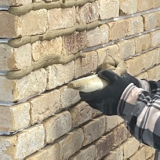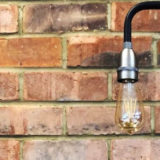
With so many choices out there it can be difficult to know where to start when looking at external cladding solutions. The type of cladding you choose will affect how a building performs in terms of weather proofing, protection and insulation and the kind of maintenance it will require over time. Just as importantly it will define the overall appearance of a building and how it relates to its environment.
A carefully considered cladding specification can make a building strategically blend in with its environment or stand out from the crowd for all the right reasons.
Modern materials and construction techniques mean that options are no longer limited to brick, stone, timber or render. Whilst these materials remain popular options, there are now some cladding alternatives on the market which are well worth considering.

Brick Slips
Brick slips are now a more popular choice than ever and look fantastic on both contemporary and more traditional homes.
One of the more versatile external cladding solutions due to the huge range of options available, brick slips are light weight slices of real brick (usually 20mm thick) that are applied just like tiles using a rapid setting tile adhesive and brick slip spacers. Once the adhesive has cured it can be pointed using a gun injected pointing mortar.
This creates a realistic look indistinguishable from traditional brick and is perfect where the appearance of real brick is required to match the local vernacular. Corners, headers and reveals are available along with the standard profile slip so on closer inspection the detailing can be just as impressive as the overall effect.
Brick slips are easy to work with for the DIY enthusiast and can allow for complex and intricate designs that wouldn’t be possible with traditional brick. They can be installed on almost any surface as long as the substrate is structurally sound and able to bear the weight, and once fixed and pointed they are durable, weatherproof and maintenance free.
Timber Cladding
Timber cladding can be a great way of giving a fresh look to a tired and dated home. It is sustainable, insulating and easy to install. Boards are typically mounted horizontally for greater resistance to moisture penetration and fixed to battens on a breather membrane or vapour barrier.
At the cheaper end of the market we have basic softwood boarding. Due to its vulnerability to the elements softwood needs regular staining or painting and is therefore a relatively maintenance intensive option. This can, over time, actually work out to be more expensive than some hardwoods.

Timbers that typically require no staining or treatment, such as Western redcedar, European larch, douglas fir or European oak are significantly more expensive but have a natural resistance to decay and moisture absorption. These timbers can last for 60 years or so with little maintenance and are designed to weather attractively with time.
Timber alternatives
Shakes and shingles have an appearance more like timber tiles than boards and offer an interesting option. While the current trend for using charred timber cladding (a process originating from Japan and known as Shou Sugi Ban) makes for an attractive black finish with lots of visual impact.
PVCu Cladding
Looking for zero maintenance cladding solutions? PVCu cladding could be just the ticket. Available in many different colours and finishes, PVCu cladding is an easy to fit option that is both lightweight and hardwearing.
While the detailing is not always as delicate as that of timber cladding, PVCu requires no maintenance and the higher quality variants come with up to 20 year discolouration guarantees.
Although PVCu can be one of the cheapest cladding options, it is worth bearing in mind that some of the premium quality versions can exceed the cost of timber.
Render
Still one of the most popular cladding solutions, render is a wet coat material which is applied much like plaster. Perfect for use where existing brickwork is not up to scratch, render provides an excellent finish when specified well and applied correctly.
Although it is possible to do it yourself, rendering can be a tricky skill to master and is probably best left to the professionals if you have no prior experience.
Over the past decade or so more sophisticated pre-packed render mixes have been brought to the market which offer extra flexibility reducing the likelihood of cracking and through-colouring, which means no painting.
Periodic cleaning is still going to be required, although some products are now available which are marketed as being resistant to pollution and are effectively self-cleaning.
Tile Hung Cladding
Tiles and slates are most often thought of as roofing materials but they can also provide a traditional and thermally efficient finish for external walls. A prominent feature of many traditional properties in the South-East of England, tile hung cladding is both efficient and characterful albeit relatively expensive.
Modern Tile Cladding
As well as traditional tiles, vertical cladding units and sheeting are available in a range of materials. Materials such as copper, zinc, galvanised and stainless steel. Each of which will have their own unique properties and installation requirements. Large format porcelain tile cladding is also available for a contemporary look.
So which of these cladding solutions is right for you?
The location of your property, your attitude towards ongoing maintenance is paramount. The requirements of your local planning authority and, ultimately, your budget will all influence the material you choose for your external cladding.
Here at BrickSlips we firmly believe in the advantages that our products have over other external cladding solutions. From a simple facelift to a full exterior renovation, brick slips can transform your property beyond recognition.
Light weight, easy to work with, cost effective and maintenance-free. Brick slips are a versatile solution that will stand the test of time.

































